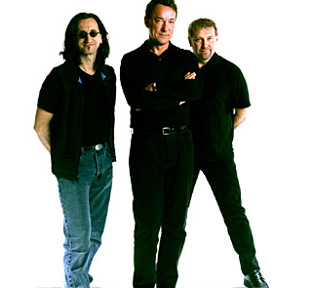
Recently resurgent Canadian power trio Rush brought their Time Machine Tour to the Nikon Theatre at Jones Beach on Saturday night. If only they’d brought all of their best material with them.
To their faithful fans, Rush is known for pulling out all the stops. While the H.G. Wells meets Orson Welles “steam punk” aesthetic they’ve created for this tour was a feast for the eyes; and the videos they’ve compiled to accompany their set list were by turns hilarious and enthralling, Rush fell a bit short where their biggest strength lies – in the music.
The problem was not the playing, but the song selection. Geddy Lee’s voice was in fine form, his bass playing thick and thunderous. The always underrated guitarist Alex Lifeson was animated throughout and Rush’s real “time machine,” the inimitable drummer Neil Peart, was as sinewy and stoic as ever.
But as it unfolded, the early part of the night found Rush indulging an unhealthy dose of underwhelming material from their recent past. After storming out of the gate with the classic “The Spirit of Radio,” Lee, Lifeson and Peart took a lackluster trip through several lukewarm numbers like “Time Stand Still,” “Presto” and “Stick It Out.” By the time they brought the first set home with ferocious, full throttle versions of “Freewill” and “Subdivisions,” much of the momentum was fizzling.
The second set was a shot of redemption. The centerpiece of the show has Rush playing their 1980 classic album Moving Pictures in its entirety. Although they’ve been playing a good portion of this landmark record on every tour since its release thirty years ago, hearing it as a single musical statement was a joyous revelation. “Tom Sawyer” was accompanied by some hysterical self-deprecating video and the auto-centric “Red Barchetta” found the band doing 100 mph in the turns.
The highlight of this excursion was the elusive opus “The Camera Eye,” Peart’s poetic love letter to modern urban life. With multiple, seamless parts and an elegiac 11-minute arrangement, the adored but rarely heard gem gave all three virtuosos a chance to spread their wings in a triumphant “Rush really is a jam band!” space.
As the piece unfolded, Lee pulled hyper-focused triple duty on vocals, keyboards and bass, Peart dug deep into his intricate drum arrangement and Lifeson went into full rock star mode, slinging his guitar down low and dropping huge power chords that washed over the sonic landscape. When the final bridge brought his solo around, Lifeson bathed in the moment, shredding as if it was his first – and maybe last – shot at it.
While the Time Machine tour has a retrospective intent, Rush is not on a nostalgia trip. They’re actually in the midst of writing and recording the forthcoming Clockwork Angels. While the work in progress is a concept album (one of Rush’s past staples), the always experimental trio has fully embraced new modes of technology to get the word and the music out. Ahead of this tour they released digital downloads of two new songs. “BU2B” (“Brought Up To Believe”) and “Caravan” have been getting the live treatment – and if they’re any indication – the future of Rush is as heavy, intricate and powerful as any part of their celebrated prog rock past.


No Comments comments associated with this post